A New 30" Contender: HP ZR30w Review
by Brian Klug on June 1, 2010 6:30 PM EST
ZR30w Color Quality
We’ll start out with the color quality of the ZR30w. As per usual, we report two metrics: color gamut and color accuracy (Delta E). Color gamut refers to the range of colors the display is able to represent with respect to some color space. In this case, our reference is the AdobeRGB 1998 color space, which is larger than the sRGB color space. So our percentages are reported with respect to this number, and larger is better.
Color accuracy (Delta E) refers to the display’s ability to display the correct color requested by the GPU. The difference between the color represented by the display, and the color requested by the GPU is our Delta E, and lower is better here. In practice, a Delta E under 1.0 is perfect - the chromatic sensitivity of the human eye is not great enough to distinguish a difference. Moving up, a Delta E of 2.0 or less is generally considered fit for use in a professional imaging environment - it isn’t perfect, but it’s hard to gauge the difference. Finally, Delta E of 4.0 and above is considered visible with the human eye. Of course, the big consideration here is frame of reference; unless you have another monitor or some print samples (color checker card) to compare your display with, you probably won’t notice. That is, until you print or view media on another monitor. Then the difference will be very apparent.
As I mentioned in our earlier reviews, we’ve updated our display test bench. We’ve deprecated the Monaco Optix XR Pro colorimeter in favor of an Xrite i1D2 since there are no longer up-to-date drivers for modern platforms. We’ve also done testing and verification with a Spyder 3 colorimeter. We’re using the latest version of ColorEyes Display Pro - 1.52.0r32, for both color tracking and brightness testing.
We’re providing data from other display reviews taken with the Monaco Optix XR alongside new data taken with an Xrite i1D2. They’re comparable, but we made a shift in consistency of operator and instrumentation, so the comparison isn’t perfect. It’s close, though.
For these tests, we calibrate the display and try to obtain the best Delta E we can get at both 200 nits and 100 nits (print brightness). We target 6500K and a gamma of 2.2, but sometimes performance is better using the monitor’s native measured whitepoint and gamma. We also take uncalibrated measurements that show performance out of box using the manufacturer supplied color profile. For all of these, dynamic contrast is disabled. The ZR30w has no other controls save brightness, which we manually adjust to hit our 200 nit and 100 nit targets.
So, how does the ZR30w do? Let’s dive into the charts:
We’ll start out with the color quality of the ZR30w. As per usual, we report two metrics: color gamut and color accuracy (Delta E). Color gamut refers to the range of colors the display is able to represent with respect to some color space. In this case, our reference is the AdobeRGB 1998 color space, which is larger than the sRGB color space. So our percentages are reported with respect to this number, and larger is better.
Color accuracy (Delta E) refers to the display’s ability to display the correct color requested by the GPU. The difference between the color represented by the display, and the color requested by the GPU is our Delta E, and lower is better here. In practice, a Delta E under 1.0 is perfect - the chromatic sensitivity of the human eye is not great enough to distinguish a difference. Moving up, a Delta E of 2.0 or less is generally considered fit for use in a professional imaging environment - it isn’t perfect, but it’s hard to gauge the difference. Finally, Delta E of 4.0 and above is considered visible with the human eye. Of course, the big consideration here is frame of reference; unless you have another monitor or some print samples (color checker card) to compare your display with, you probably won’t notice. That is, until you print or view media on another monitor. Then the difference will be very apparent.
As I mentioned in our earlier reviews, we’ve updated our display test bench. We’ve deprecated the Monaco Optix XR Pro colorimeter in favor of an Xrite i1D2 since there are no longer up-to-date drivers for modern platforms. We’ve also done testing and verification with a Spyder 3 colorimeter. We’re using the latest version of ColorEyes Display Pro - 1.52.0r32, for both color tracking and brightness testing.
We’re providing data from other display reviews taken with the Monaco Optix XR alongside new data taken with an Xrite i1D2. They’re comparable, but we made a shift in consistency of operator and instrumentation, so the comparison isn’t perfect. It’s close, though.
For these tests, we calibrate the display and try to obtain the best Delta E we can get at both 200 nits and 100 nits (print brightness). We target 6500K and a gamma of 2.2, but sometimes performance is better using the monitor’s native measured whitepoint and gamma. We also take uncalibrated measurements that show performance out of box using the manufacturer supplied color profile. For all of these, dynamic contrast is disabled. The ZR30w has no other controls save brightness, which we manually adjust to hit our 200 nit and 100 nit targets.
So, how does the ZR30w do? Let’s dive into the charts:
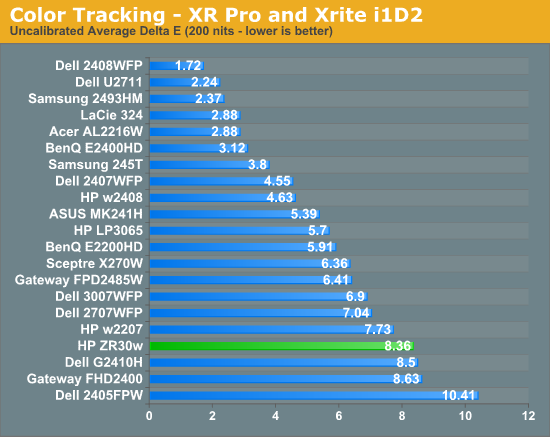
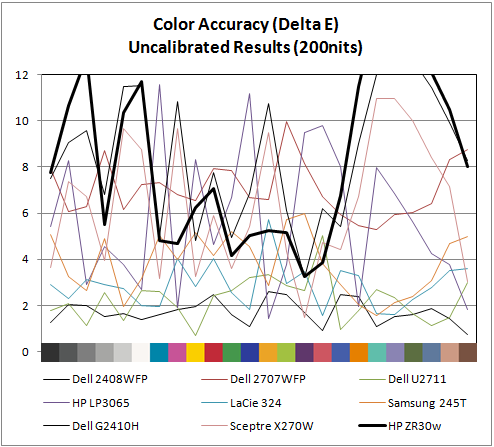

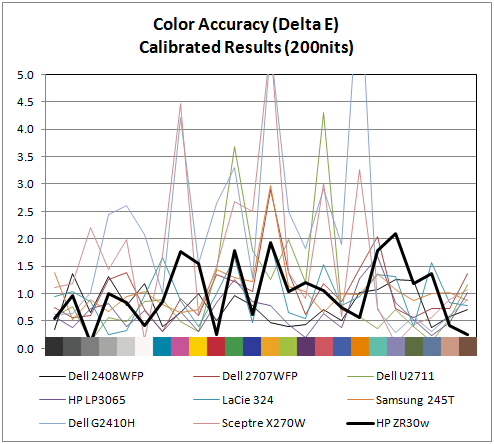
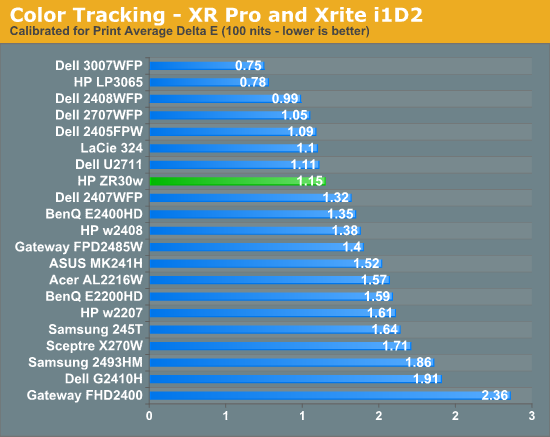
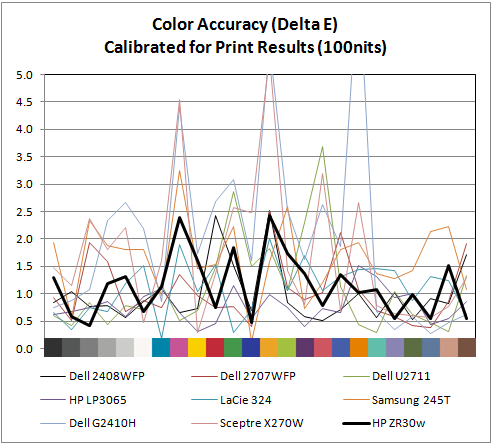
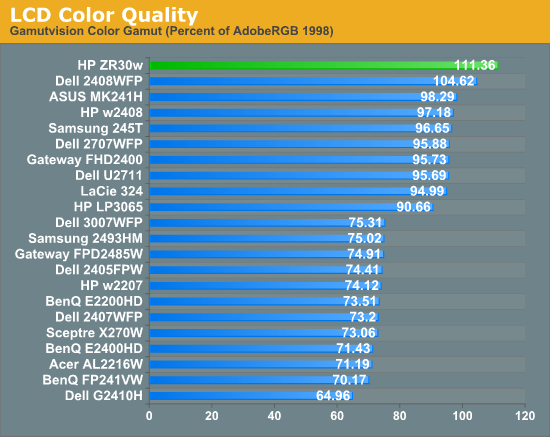
Out of box, the ZR30w looks a tad cool in temperature and is very vibrant. Perhaps even too vibrant, but then again maybe that's what 1 billion colors looks like. I’m a bit surprised that uncalibrated performance isn’t better than what I measured. I ran and re-ran this test expecting something to be wrong with my setup - it just doesn’t perform very well in this objective uncalibrated test. That isn’t to say it doesn’t look awesome - it does - but the ZR30w strongly benefits from calibration.
Moving to calibrated performance at 200 nits, the ZR30w really starts to deliver, with impressive Delta E of 1.01. Pay attention to the charts, there's not a single peak above 2.0, which is awesome. I couldn’t get the ZR30w all the way down to 100 nits - the lowest the display will go is right around 150 nits. Surprisingly, Delta E actually gets a bit worse, and moves up to 1.15 at the dimmest setting. Interestingly, the highest peak jumps up to 2.5 at this brightness. I’ll talk more about brightness in a second, but it’s pretty obvious that the ZR30w wants to be bright. You can just tell from the dynamic range you can get to in the menus, from 150 nits up to the maximum around 400, and it’s somewhere inbetween there that Delta E really really shines.
Of course, the ZR30w delivers in color gamut. Note that in the volumetric 3D plot, the wireframe plot is the ZR30w, and the solid plot is AdobeRGB 1998 - that’s right, we’ve exceeded the AdobeRGB color space. The raw data is impressive, the display manages 111.36% of coverage, the highest we’ve tested. In this case, we’ve exceed the manufacturer claims of 99% AdobeRGB by a notable margin. I have no trouble believing that HP's claims about 1+ billion colors are totally accurate - you have to see it in person to believe it. There are just some colors I'm used to not seeing represented very well; reds and blues especially, and the photos that I have looked at are spectacular.
IPS panels are still very, very win. It’d be awesome to see a Delta E under 1.0, but I just couldn’t get that from the ZR30w I tested. The additional difference would of course be absolutely indistinguishable to the human eye, but it’d be an awesome bragging right. But you've already got more than a billion colors.
Moving to calibrated performance at 200 nits, the ZR30w really starts to deliver, with impressive Delta E of 1.01. Pay attention to the charts, there's not a single peak above 2.0, which is awesome. I couldn’t get the ZR30w all the way down to 100 nits - the lowest the display will go is right around 150 nits. Surprisingly, Delta E actually gets a bit worse, and moves up to 1.15 at the dimmest setting. Interestingly, the highest peak jumps up to 2.5 at this brightness. I’ll talk more about brightness in a second, but it’s pretty obvious that the ZR30w wants to be bright. You can just tell from the dynamic range you can get to in the menus, from 150 nits up to the maximum around 400, and it’s somewhere inbetween there that Delta E really really shines.
Of course, the ZR30w delivers in color gamut. Note that in the volumetric 3D plot, the wireframe plot is the ZR30w, and the solid plot is AdobeRGB 1998 - that’s right, we’ve exceeded the AdobeRGB color space. The raw data is impressive, the display manages 111.36% of coverage, the highest we’ve tested. In this case, we’ve exceed the manufacturer claims of 99% AdobeRGB by a notable margin. I have no trouble believing that HP's claims about 1+ billion colors are totally accurate - you have to see it in person to believe it. There are just some colors I'm used to not seeing represented very well; reds and blues especially, and the photos that I have looked at are spectacular.
IPS panels are still very, very win. It’d be awesome to see a Delta E under 1.0, but I just couldn’t get that from the ZR30w I tested. The additional difference would of course be absolutely indistinguishable to the human eye, but it’d be an awesome bragging right. But you've already got more than a billion colors.


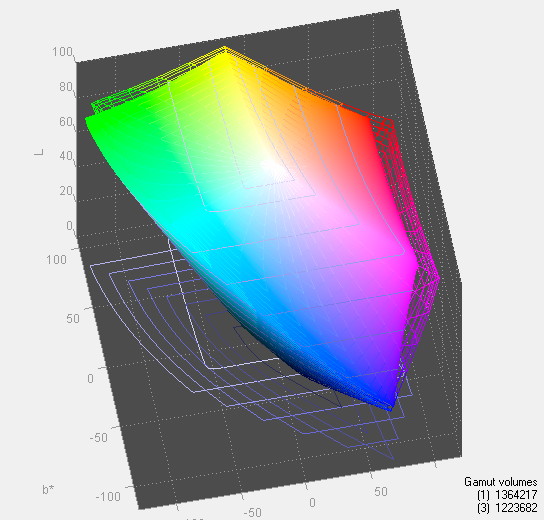








95 Comments
View All Comments
boe - Wednesday, June 2, 2010 - link
I've been waiting to buy some monitors for years as the 3008WFP had it's share of issues and Apple hasn't released a new LED backlit 30" yet.I'm looking forward to getting a couple of new monitors but not until some higher end models come out with a clear improvement over my 3007wfp's.
xismo - Wednesday, June 2, 2010 - link
I find it a bit dissapointing that you don't list the configuration this was tested on. For example I don't know the gpu the monitor was running on and therefore I wouldn't know whether the gpu had 10-bit support. It would be nice if you could try to add test of 10-bit support as well, how it performs with smooth gradients and so on. As you probably know not too many graphics cards support 10-bit, but all of the workstation class cards do, which I think is appropriate for testing with high end monitors.xismo - Wednesday, June 2, 2010 - link
After reading the comments I see there was a discussion about 10-bit support, sorry for not seeing that earlier. At least I'm not the only one concerned about this :) BTW 5870 does not have 10-bit support as almost all of the other gaming video cards. And using a mini displayport on a macbook pro will not make the geforce 330m have 10-bit support either. Displayport as well as dual link dvi are the only types of connection that are able to process 10-bit color, but you still need a matching video card. Any workstation card like quadro or firepro should be just fine. But yeah including how each monitor displays gradients would be a huge advantage for me, as this is one of the things I'm looking for in a new monitor.Brian Klug - Wednesday, June 2, 2010 - link
Hey there! Thanks for the comment, yeah I'm working on getting us either a workstation GPU or some other way (whole workstation) to really test the 10-bit aspect. It'll happen this week or next and then I'll update. I realized after posting that I forgot to make sure it was working over 10-bit. And you're right about the 5870-it doesn't have 10-bit support. Guess that's one of those arguments for a more expensive workstation version of the card!Cheers!
Brian Klug
awaken688 - Wednesday, June 2, 2010 - link
I'm surprised no one has really complained about the brightness limitation. For professional photographers and graphic artists (the target audience), this would be rough to have no way to see below 150nits as a real means to check for print accuracy. For some of our print shops, 100 nits is accurate to print.Brian,
Did you try adjusting the brightness via the video card as well? I have a monitor that on 0 brightness is still too bright, but I can then go into nVidia's control panel and lower the brightness using that to achieve the correct brightness or lower the RGB manually (which I understand isn't an option for this monitor). Just wondering. Nonetheless, this should at least be able to hit 120 nits for imaging professionals. Good article though. I like the monitor reviews for sure.
Soldier1969 - Wednesday, June 2, 2010 - link
Thanks for the review, not a bad price for a new 30 incher compared to other brands. Those people here that want 24" reviews those are a dime a dozen and for the poor. I had a 24" 1920 x 1200 monitor long before most did since 2007 when they cost a fortune. So glad I jumped to 2560 x 1600, gaming on them owns everything else out there! Blu ray looks fantastic! If youve never experienced computing on a 30 incher your missing out!kasakka - Thursday, June 3, 2010 - link
The lack of OSD is what kills this for me. I find that without it getting accurate colors is more difficult and if you want to also use the display for gaming, some games may totally ignore calibrated color profiles or software adjustments. The lack of a scaler is a bit annoying too, but since graphics cards can do that at least in Windows, it's not really a problem.Regarding inputs, I currently have a Dell 3008WFP and its gazillion inputs is a huge minus for me. I only need one DVI and one Displayport, so having to cycle thru all the useless inputs is annoying. More annoying is the 3008WFP's (and the 27" Dell U2711's) circa 5 second delay when swithing resolutions or inputs. But I guess I'll stick with the Dell until someone comes out with something better.
pmeinl - Thursday, June 3, 2010 - link
Does the AG coating of the ZR30 have this annoying sparkle effect like other current IPS panels (ex: U2410).Working on my two U2410 (programming, text processing) causes me eye strain.
pmeinl - Friday, June 4, 2010 - link
As some people do not see the sparkle problem, here is a thread with a picture of it:http://hardforum.com/showthread.php?t=1466914&...
B3an - Thursday, June 3, 2010 - link
So just to be clear... does this display do more colors than the Dell 3008?